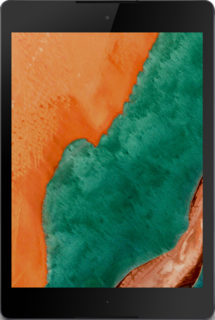
The Nexus One is an Android smartphone designed and manufactured by HTC as Google's first Nexus smartphone. The Nexus became available on January 5, 2010, and features the ability to transcribe voice to text, an additional microphone for dynamic noise suppression, and voice guided turn-by-turn navigation to drivers.
Dipljapyx is a genus of diplurans in the family Japygidae.
Google Nexus was a line of consumer electronic devices that ran the Android operating system. Google managed the design, development, marketing, and support of these devices, but some development and all manufacturing were carried out by partnering with original equipment manufacturers (OEMs). The line also included tablets and streaming media players, though neither type of device are currently available. The most recent tablet was the Nexus 9, and the most recent streaming media player the Nexus Player.

The Nexus S 4G is a smartphone co-developed by Google and Samsung and manufactured by Samsung Electronics for release in 2010. It was the first smartphone to use the Android 2.3 "Gingerbread" operating system, and the first Android device to support Near Field Communication (NFC) in both hardware and software.
The version history of the Android mobile operating system began with the public release of the Android beta on November 5, 2007. The first commercial version, Android 1.0, was released on September 23, 2008. Android is continually developed by Google and the Open Handset Alliance (OHA), and it has seen several updates to its base operating system since the initial release.

The Galaxy Nexus (GT-I9250) is a touchscreen Android smartphone co-developed by Google and Samsung Electronics. It is the third smartphone in the Google Nexus series, a family of Android consumer devices built by an original equipment manufacturer partner. The phone is the successor to Google's previous flagship phones, the Nexus One and Nexus S.

Nexus Q is a digital media player developed by Google. Unveiled at the Google I/O developers' conference on June 27, 2012, the device was expected to be released to the public in the United States shortly thereafter for US$300. The Nexus Q was designed to leverage Google's online media offerings, such as Google Play Music, Google Play Movies & TV, and YouTube, to provide a "shared" experience. Users could stream content from the supported services to a connected television, or speakers connected to an integrated amplifier, using their Android device and the services' respective apps as a remote control for queueing content and controlling playback.

The first-generation Nexus 7 is a mini tablet computer co-developed by Google and Asus that runs the Android operating system. It is the first tablet in the Google Nexus series of Android consumer devices marketed by Google and built by an original equipment manufacturer partner. The Nexus 7 features a 7.0-inch (180 mm) display, an Nvidia Tegra 3 quad-core chip, 1 GB of memory, Wi-Fi and near field communication connectivity, and 8, 16 or 32 GB of storage. The tablet was the first device to ship with version 4.1 of Android, nicknamed "Jelly Bean". By emphasizing the integration of the Google Play multimedia store with Android 4.1, Google intended to market the Nexus 7 as an entertainment device and a platform for consuming e-books, television shows, films, games, and music.

The Nexus 4 is an Android smartphone co-developed by Google and LG Electronics. It is the fourth smartphone in the Google Nexus product family, unveiled on October 29, 2012, and released on November 13, 2012, and succeeded the Samsung-manufactured Galaxy Nexus. As with other Nexus devices, the Nexus 4 was sold unlocked through Google Play, but was also retailed by wireless carriers.

The Nexus 10 is a tablet computer co-developed by Google and Samsung Electronics that runs the Android operating system. It is the second tablet in the Google Nexus series, a family of Android consumer devices marketed by Google and built by an OEM partner. Following the success of the 7-inch Nexus 7, the first Google Nexus tablet, the Nexus 10 was released with a 10.1-inch, 2560×1600 pixel display, which was the world's highest resolution tablet display at the time of its release. The Nexus 10 was announced on October 29, 2012, and became available on November 13, 2012.

The Nexus 6 is a phablet co-developed by Google and Motorola Mobility that runs the Android operating system. The successor to the Nexus 5, it is the sixth smartphone in the Google Nexus series, a family of Android consumer devices marketed by Google and built by an original equipment manufacturer partner. Nexus 6 and the HTC Nexus 9 served as the launch devices for Android 5.0 "Lollipop".

The second generation Nexus 7 is a mini tablet computer co-developed by Google and Asus that runs the Android operating system. It is the third tablet in the Google Nexus series, a family of Android consumer devices marketed by Google and built by an original equipment manufacturer partner. Following the success of the original Nexus 7, a second generation of the device was released on July 26, 2013, four days earlier than the originally scheduled date due to early releases from various retailers. The tablet was the first device to ship with Android 4.3.

Nexus 5 is an Android smartphone manufactured by LG Electronics for Google. Co-developed with and marketed by Google Inc. as part of its Nexus line of flagship devices and unveiled on October 31, 2013, the Nexus 5 served as the launch device for Android 4.4 "KitKat", which introduced a refreshed interface, performance improvements, increased Google Now integration, better battery life and other features.

The Nexus 9 is a tablet computer co-developed by Google and HTC that runs the Android operating system. It is the fourth tablet in the Google Nexus series, a family of Android consumer devices marketed by Google and built by an OEM partner. The device is available in two storage sizes, 16 GB for US$399 and 32 GB for US$479. Along with the Nexus 6 mobile phone and Nexus Player digital media device, the Nexus 9 launched with 5.0 Lollipop, which offered several new features, notably a modified visual appearance, and the complete replacement of the Dalvik virtual machine with ART. Google has included an additional step to "Enable OEM unlock" before users can unlock the Nexus 9 bootloader.
The Nexus Player is a digital media player co-developed by Google, Intel and Asus. It is the second media player in the Google Nexus family of consumer devices. Originally running the Android 5.0 ("Lollipop") operating system, it is the first device to employ the Android TV platform. The Nexus player supports Google Cast, the feature for selecting and controlling media playback on a television that was first introduced by Chromecast. Sales of the Nexus Player were discontinued in May 2016, and product support ended in March 2018.

Nexus 5X is an Android smartphone manufactured by LG Electronics, co-developed with and marketed by Google as part of its Nexus line of flagship devices. Unveiled on September 29, 2015, it is a successor to the Nexus 5. The phone, along with the Nexus 6P, served as launch devices for Android 6.0 Marshmallow, which introduced a refreshed interface, performance improvements, increased Google Now integration, and other new features.

Nexus 6P is an Android smartphone developed and marketed by Google and manufactured by Huawei. It succeeded the Nexus 6 as the flagship device of the Nexus line of Android devices by Google. Officially unveiled on 29 September 2015 along with the Nexus 5X at the Google Nexus 2015 press event held in San Francisco, it was made available for pre-order on the same day in United States, United Kingdom, Ireland, and Japan.
Dipljapyx hirpinus is a species of forcepstail in the family Japygidae.
Dipljapyx italicus is a species of forcepstail in the family Japygidae.
Dipljapyx limbarae is a species of forcepstail in the family Japygidae.












